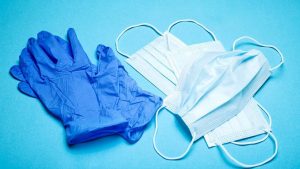
PPE
Face coverings have become mandatory in some shops and supermarkets in England. In terms of the law, in England, people are required to wear face coverings:
- on public transport
- in airports, rail and tram stations, ports, bus and coach stations and terminals
- in shops and supermarkets
- at indoor shopping centres
- in banks, building societies and post offices.
For members of the public, from 8 August the places where you will have to wear a face covering will be expanded to include:
- funeral directors
- premises providing professional, legal or financial services
- cinemas
- theatres
- bingo halls
- concert halls
- museums, galleries, aquariums, indoor zoos or visitor farms, or other indoor tourist, heritage or cultural sites.
- nail, beauty, hair salons and barbers – other than where necessary to remove for treatments
- massage parlours
- public areas in hotels and hostels
- place of worship
- libraries and public reading rooms
- community centres
- social clubs
- tattoo and piercing parlours
- indoor entertainment venues (amusement arcades, funfairs, adventure activities e.g. laser quest, go-karting, escape rooms, heritage sites etc)
- storage and distribution facilities
- veterinary services.
- auction houses
However, people with mental or physical illnesses or disabilities are exempt from the requirements — if wearing a face covering makes it difficult to breathe for example, such as in the case of respiratory conditions like asthma.
Asthma and Face Coverings – Understanding the Exemptions! A downloadable exemption card has been produced for people to show on their phones or elsewhere to explain why they’re not wearing a mask. However, people are not obliged by law to show the card if they are challenged on face masks.
The reason for using face coverings.
Coronavirus (COVID-19) usually spreads by droplets from coughs, sneezes and speaking. These droplets can also be picked up from surfaces, if you touch a surface and then your face without washing your hands first. This is why social distancing, regular hand hygiene, and covering coughs and sneezes is so important in controlling the spread of the virus.
The best available scientific evidence is that, when used correctly, wearing a face covering may reduce the spread of coronavirus droplets in certain circumstances, helping to protect others.
Face coverings are mainly intended to protect others, not the wearer, from coronavirus (COVID-19) they are not a replacement for social distancing and regular hand washing. It is important to follow all the other government advice on coronavirus (COVID-19) including staying safe outside your home. If you have recent onset of any of the most important symptoms of coronavirus (COVID-19):
- a new continuous cough
- a high temperature
- a loss of, or change in, your normal sense of smell or taste (anosmia)
you and your household must isolate at home: wearing a face covering does not change this.
How to wear a face covering.
A face covering should:
- cover your nose and mouth while allowing you to breathe comfortably
- fit comfortably but securely against the side of the face
- be secured to the head with ties or ear loops
- be made of a material that you find to be comfortable and breathable, such as cotton
- ideally include at least two layers of fabric (the World Health Organisation recommends three depending on the fabric used)
- unless disposable, it should be able to be washed with other items of laundry according to fabric washing instructions and dried without causing the face covering to be damaged
When wearing a face covering you should:
- wash your hands thoroughly with soap and water for 20 seconds or use hand sanitiser before putting a face covering on
- avoid wearing on your neck or forehead
- avoid touching the part of the face covering in contact with your mouth and nose, as it could be contaminated with the virus
- change the face covering if it becomes damp or if you’ve touched it
- avoid taking it off and putting it back on a lot in quick succession (for example, when leaving and entering shops on a high street)
When removing a face covering:
- wash your hands thoroughly with soap and water for 20 seconds or use hand sanitiser before removing
- only handle the straps, ties or clips
- do not give it to someone else to use
- if single-use, dispose of it carefully in a residual waste bin and do not recycle
- if reusable, wash it in line with manufacturer’s instructions at the highest temperature appropriate for the fabric
- wash your hands thoroughly with soap and water for 20 seconds or use hand sanitiser once removed
Contact us for further information.
